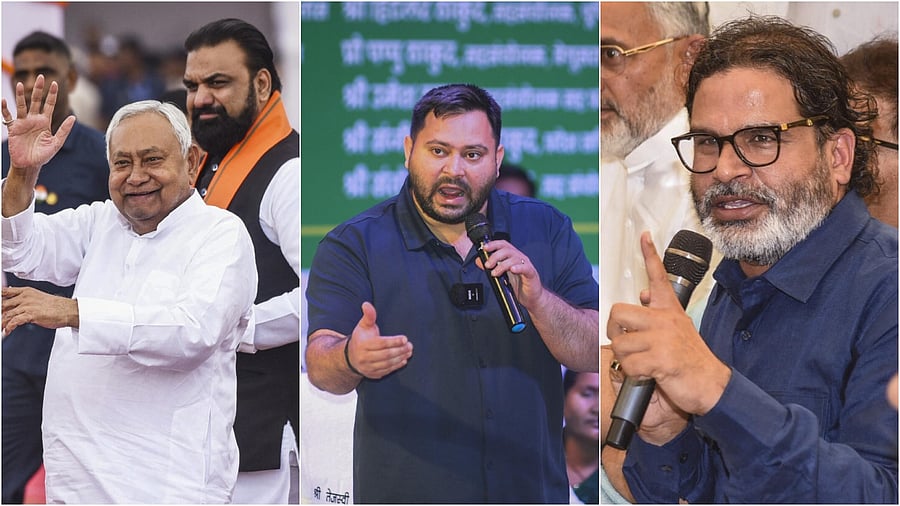
From left: Nitish Kumar, Tejashwi Yadav and Prashant Kishore.
Credit: PTI Photos
New Delhi: Over the last two decades, Bihar elections have not been about securing an absolute majority.
Such is the nature of the fragmented polity since 2005 that every time the Election Commission announces the poll schedule, the key constants—both within and outside their respective alliances—line up knowing fully well that none can cross the halfway mark on its own.
The realistic approach, thus, is to emerge as the dominant partner within the alliance and the single largest party in the state Assembly, even if it means undercutting one’s pre-poll partner a bit. And 2025 may not be any different.
A lead position in the Assembly bolsters one’s chance to claim the chief ministership within the pre-poll alliance. Or that was the case till Nitish Kumar came along.
In a series of stunning political somersaults, Nitish demonstrated that one could reign over the throne in Patna with fewer MLAs if one could tilt the scales of power between Lalu Yadav’s RJD and Narendra Modi’s BJP by walking in and out of an alliance with a committed 13 to 20% vote share.
The ‘N-factor’ has considerably weakened in the last five years. Nonetheless, it has successfully held out against the BJP’s unfettered march to political dominance in the heartland states, forcing the saffron outfit to lean on the JD(U) every now and then.
The 2020 polls were marred by a new normal in state politics when Lok Janshakti Party’s Chirag Paswan, an NDA ally, decided to go solo, selectively undercutting the JD(U) while sparing the BJP in most seats. Will it be different this time around if the BJP wins more seats?
I.N.D.I.A. bloc
The RJD, led by Lalu’s son and former deputy CM Tejaswi Yadav, emerged as the single largest party with 75 seats in the last Assembly polls. That’s the RJD’s best performance without Nitish Kumar by its side.
And yet it had to continue in the Opposition benches because the BJP and the JD(U) combined could poll just enough votes to cross the halfway mark.
The outcome also showed the limitations of social combination stitched by the I.N.D.I.A. bloc, relying chiefly on the Muslim and Yadav voters, leaving the NDA unchallenged over a vast tract, especially in north Bihar.
In Muslim-dominated Seemanchal, AIMIM’s Asaduddin Owaisi continues to push the envelope further. He won 5 seats in 2020, and every vote he takes is at the cost of the RJD.
The Congress has failed to bring much to the table in Bihar. In 2020, it dragged the alliance down with a dismal strike rate by winning just 19 seats out of 70 allocated by the RJD. Rahul Gandhi’s yatra has invigorated the party cadre and its organisation. But will that be enough to convert votes into seats?
The silver lining for the I.N.D.I.A. bloc in Bihar has been the emergence of CPI (Marxist-Leninists). In 2020, the party won 12 out of 19 seats in south and central Bihar.
The X factor
Election strategist-turned-politician Prashant Kishor’s Jan Suraaj is the new kid in town.
Kishor has focused on Bihar’s economy, development and unemployment, calling upon youth to seek change. On the face of it, he may appear to be impinging on NDA’s core constituency. But the devil lies in the details of Kishor’s candidate list.
In a state where caste remains a decisive factor, much would depend on Jan Suraaj’s candidate selection, especially if Kishor were to pick local strongmen who fail to make the cut in the I.N.D.I.A. and the NDA list. The vote difference between NDA and the I.N.D.I.A. bloc in the last elections was less than 15,000 votes. In a close contest, every vote counts. The smaller and non-aligned forces, thus, can play a tactical role.